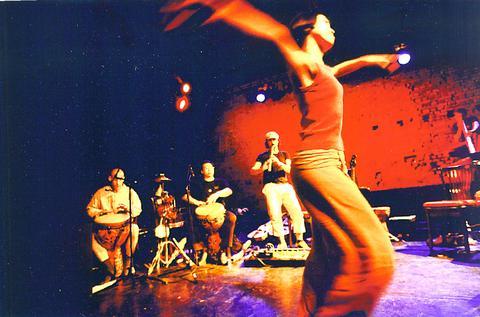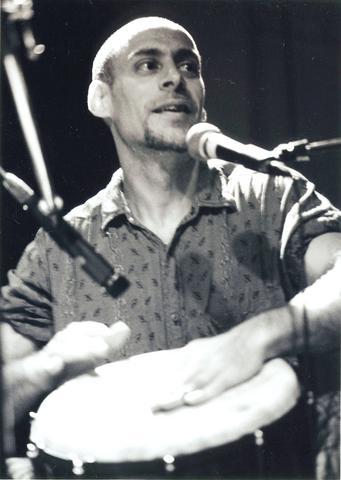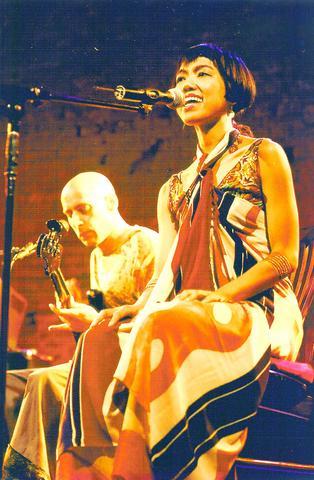Scott Prairie and Mia Hsieh (
"It involves finding your own improvisational ideas, but then having a point of contact," Prairie explained, then demonstrated by tapping Hsieh on the arm.

PHOTOS COURTESY OF ALBERTO BUZZOLA
"It's about energy following reasoning," Hsieh said, picking up where Prairie left off.

If you don't follow the reasoning, don't worry, it's easier to follow Hsieh and Prairie's energy.
What started as a bump at that New York City workshop blossomed into a friendship, a creative collaboration, a marriage and, more recently, A Moving Sound (

The sound it serves up is best described by its ingredients. Prairie trained in classical music on the French horn but gave it up for psychology. Hsieh came to singing and dancing by way of theater administration. By the time Prairie met Hsieh, he had already gone back to music and bought a bass guitar that he'd retuned to get the effect he wanted. By the time she met Prairie, Hsieh had already stopped administering theater troupes in Taiwan to explore her own creativity in New York as part of a Fulbright scholarship.
Prairie tells of how Hsieh found her voice at a vocalization workshop at New York City's CBGB, after which the workshop organizers held an impromptu contest.
"The contest was yodeling," Prairie said. "Somebody dragged Mia on stage with all these crazy vocalists taking their turn. And when it came her turn she said `What is yodeling?' ... So somebody yodeleheehooed -- put it in her ear. She just let it fly and won the contest."
Her prize, she learned later, was six weeks of voice lessons with a contemporary of Meredith Monk, the pioneer of "extended vocal technique," whose work intersects music and movement.
"Before that, most of my experience was dance" in Taiwan, Hsieh said.
Like Monk, Hsieh became interested in the combination of voice and movement. Her interest was the seed that later sprouted into her and Prairie's sister project, A Moving Sound Theater. In their musical collaborations, Hsieh will construct a vocal narrative to melodies that Prairie has written, Several of Little Universe's tracks are sung in a language Hsieh has improvised, though you have to listen closely before realizing as much. Movement is used to help move the narrative, or else to involve the audience, give them instruments or get them dancing.
But they're hardly alone in their collaboration, be it for music or theatre. A Moving Sound is joined by percussionists Alex Wu (
The quintet actually finished recording Little Universe in November of last year (It was reviewed in Taipei Times' May 9 issue of this year under its original title, Pacu's Trip) In the past year, they toured the album through several US cities -- including Los Angeles, Seattle, Portland, New York and Pittsburgh, as well as performing at the Asian Acoustic Music Festival back in Taiwan and regular appearances at the Red Theater and Wisteria Tea House, to name a few.
Their sound combines a world of elements. It's Indian-spiced and Middle-Eastern flavored. It employs African rhythms and often has the texture of Taiwanese Aboriginal music. It's eclectic, but has a universality that keeps you humming along with it.
"We like to experiment with new combinations," Prairie said. An example?
"We have one girl joining us for next week's show who is a trained circus performer who's here studying Chinese opera. She'll perform while hanging from the ceiling on a piece of cloth."
A MOVING SOUND'S LITTLE UNIVERSE
TAIPEI
Thursday, Dec. 16 @ 7:30pm
Red Theater, 10 Chengdu Rd, Ximending, Taipei (紅樓劇場 北市成都路10號). Tickets NT$400, available at the door.
TAINAN
Saturday, Dec. 18 @ 4:30pm
Eslite Bookstore Square, Tainan (台南誠品書店戶外廣場 南市東區長榮路一段181號)
Free admission
Saturday, Dec. 18 at 7:26pm, 726 Art Space, Hai-an Rd. and Hopin St, Tainan (台南七二六劇場/台南市海安路&和平街口)
Free Admission
KAOHSIUNG
Sunday, Dec. 19 at 2pm, Eslite Bookstore, 21 Sanduo Fourth Rd, 17F, Kaohsiung (高雄誠品大遠百店/高雄市苓雅區三多四路21號17F)
Free admission
Sunday, Dec. 19 at 4pm, Pier 2 Art Districts, 1 Tayung Rd, Yencheng District, Kaohsiung (高雄駁二藝術特區高雄市鹽埕區大勇路1號).
Free Admission

That US assistance was a model for Taiwan’s spectacular development success was early recognized by policymakers and analysts. In a report to the US Congress for the fiscal year 1962, former President John F. Kennedy noted Taiwan’s “rapid economic growth,” was “producing a substantial net gain in living.” Kennedy had a stake in Taiwan’s achievements and the US’ official development assistance (ODA) in general: In September 1961, his entreaty to make the 1960s a “decade of development,” and an accompanying proposal for dedicated legislation to this end, had been formalized by congressional passage of the Foreign Assistance Act. Two

Despite the intense sunshine, we were hardly breaking a sweat as we cruised along the flat, dedicated bike lane, well protected from the heat by a canopy of trees. The electric assist on the bikes likely made a difference, too. Far removed from the bustle and noise of the Taichung traffic, we admired the serene rural scenery, making our way over rivers, alongside rice paddies and through pear orchards. Our route for the day covered two bike paths that connect in Fengyuan District (豐原) and are best done together. The Hou-Feng Bike Path (后豐鐵馬道) runs southward from Houli District (后里) while the

March 31 to April 6 On May 13, 1950, National Taiwan University Hospital otolaryngologist Su You-peng (蘇友鵬) was summoned to the director’s office. He thought someone had complained about him practicing the violin at night, but when he entered the room, he knew something was terribly wrong. He saw several burly men who appeared to be government secret agents, and three other resident doctors: internist Hsu Chiang (許強), dermatologist Hu Pao-chen (胡寶珍) and ophthalmologist Hu Hsin-lin (胡鑫麟). They were handcuffed, herded onto two jeeps and taken to the Secrecy Bureau (保密局) for questioning. Su was still in his doctor’s robes at

Mirror mirror on the wall, what’s the fairest Disney live-action remake of them all? Wait, mirror. Hold on a second. Maybe choosing from the likes of Alice in Wonderland (2010), Mulan (2020) and The Lion King (2019) isn’t such a good idea. Mirror, on second thought, what’s on Netflix? Even the most devoted fans would have to acknowledge that these have not been the most illustrious illustrations of Disney magic. At their best (Pete’s Dragon? Cinderella?) they breathe life into old classics that could use a little updating. At their worst, well, blue Will Smith. Given the rapacious rate of remakes in modern